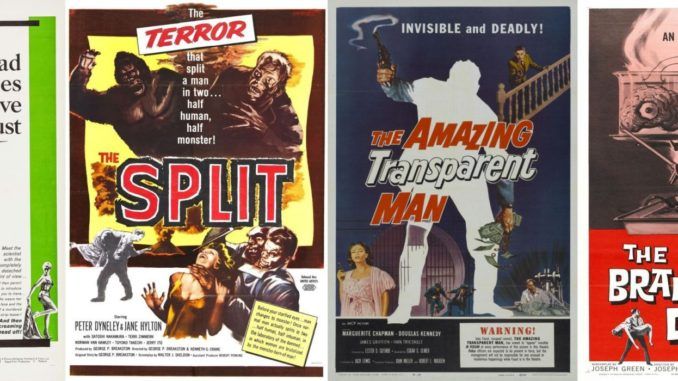
You can get a box-set of anything these days, it seems. In this case, it’s six movies spanning 1956 to 1963, linked by the loose theme of… Well, the title more or less says it all. This is a loose categorization. Some involve a head separated from its owner. Others concern the transplant of personality to a new owner, or even the entire head itself. Then you have a couple of cases where nobody goes anywhere, but the owners of said cranial appendage go through some kind of scientist-induced trauma, which causes them to change in an unfortunate way. Yeah, we’re definitely stretching the boundaries of this marketing-spawned subgenre just a tad.
 As you can imagine given the subject matter, we are very firmly operating in B-movie territory here, where price is typically no object. There’s good reason most of these have strayed across the screens of Mystery Science Theater 3000. Of particular note, The Brain That Wouldn’t Die was the first appearance of Michael J. Nelson as host. Indestructible Man, The Amazing Transparent Man and The Atomic Brain were all also featured in episodes. I’m surprised The Manster never showed up on MST3K, but that one was used for an installment of Elvira’s Movie Macabre.
As you can imagine given the subject matter, we are very firmly operating in B-movie territory here, where price is typically no object. There’s good reason most of these have strayed across the screens of Mystery Science Theater 3000. Of particular note, The Brain That Wouldn’t Die was the first appearance of Michael J. Nelson as host. Indestructible Man, The Amazing Transparent Man and The Atomic Brain were all also featured in episodes. I’m surprised The Manster never showed up on MST3K, but that one was used for an installment of Elvira’s Movie Macabre.
This leaves The Head as the only one apparently to have escaped sarcastic re-purposing. Probably for good reason, since I’d say it was easily the best of the bunch, despite having to cope with being dubbed from another language (German, to be specific). As we will see, it benefits from an excellent central performance – not something which can honestly be said about most of these. There are a couple of known names, probably led by Lon Chaney Jr., albeit in the alcoholic twilight of his career. But you can also see the influence these had on future movies, from Mars Attacks! to Re-Animator.
Indeed, you could probably assemble a separate six-pack of later movies which went along at least somewhat similar lines, such as The Thing With Two Heads or Steve Martin’s The Man With Two Brains. I’m also a little surprised the makers here didn’t include 1958’s The Thing That Couldn’t Die. I might have to cover that one in as a bonus review down the road. For now, we’ll be reviewing each entry every other day for the next… oh, work it out yourself. Speaking of which, two of these six have been reviewed on their own previously by me. In those cases I’ve included the original reviews, and added an appropriate introduction, discussing whether my opinion was any different this time around. And with that all said, let’s put our heads together…

Indestructible Man (1956)
Rating; C-
Dir: Jack Pollexfen
Star: Max Showalter, Lon Chaney Jr., Marian Carr, Ross Elliott
This is a bit of an odd beast. I can’t even bring myself to classify it as science-fiction, despite the obvious nod to the Frankenstein myth. That’s merely the starting point, after which it’s much more a noir thriller. Charles “The Butcher” Benton (Chaney) is on Death Row for his role in a robbery which netted $600,000. It’s loot whose location only he knows, and intends to take to his grave, after his accomplices turned state’s evidence against him to save their own skins. After execution, his corpse is sold to a scientist, who pumps several hundred thousand Volts through it. This is supposedly going to find a cure for cancer or something. Not quite sure how.
Anyway, this brings Benton back to life, and as the title suggests, renders him bulletproof, albeit mute. He kills the scientist and makes a beeline back to Los Angeles to take revenge on those who betrayed him. Also involved is his moll, burlesque dancer Eva Martin (Carr) and detective Lt. Dick Chasen (Showalter). He thinks Eva knows the location of the robbery proceeds, but also asks her out to dinner. Even though it’s only a drive-through hamburger, I’m sure fraternising with a material witness like this would have been frowned on, even in the fifties. After several murders committed by a dead man, the last gang member (Elliott) squeals for his own protection, telling authorities Benton is hiding in the sewers. Cue the traditional mob – albeit armed with flamethrowers and a bazooka, rather than pitchforks.
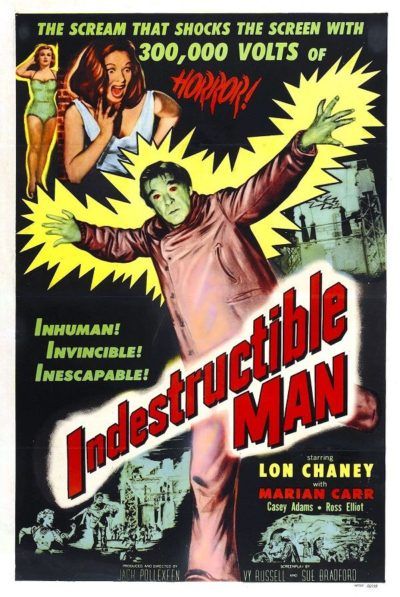 This works best as a snapshot of LA life in the fifties, with some fascinating footage shot on the streets. A sequence takes part around the famous Angels Flight funicular downtown, and one of The Butcher’s victim lives in the Bradbury Building. Twenty-five years later, that same apartment block would be used as the location of J.F. Sebastian’s apartment, and for the rooftop showdown between Deckard and Batty. This time-capsule element is more enjoyable than most of what the story has to offer. Chaney, in particular, is largely wasted. Outside of one scene, he’s not allowed to speak; it’s a shame, because that scene where he does, is pretty good. The director seems to think frequent close-ups of Benton’s sweating face make up for his lack of dialogue. [Narrator: it doesn’t]
This works best as a snapshot of LA life in the fifties, with some fascinating footage shot on the streets. A sequence takes part around the famous Angels Flight funicular downtown, and one of The Butcher’s victim lives in the Bradbury Building. Twenty-five years later, that same apartment block would be used as the location of J.F. Sebastian’s apartment, and for the rooftop showdown between Deckard and Batty. This time-capsule element is more enjoyable than most of what the story has to offer. Chaney, in particular, is largely wasted. Outside of one scene, he’s not allowed to speak; it’s a shame, because that scene where he does, is pretty good. The director seems to think frequent close-ups of Benton’s sweating face make up for his lack of dialogue. [Narrator: it doesn’t]
Probably the most interesting character is Eva, who manages to be refreshingly free of the stereotypes you’d expect from a cinematic stripper in the fifties. She’s unashamed by her job, and the scene where she and Dick enjoy that drive-through dinner is one of the few where it feels like you’re watching real people, not off-cuts from a dime detective novel. Suspending disbelief that Benton is immune to bullets is one thing; that he can take a bazooka shell and keep right on ticking is a stretch. Naturally, we find that the title is not actually true either. Spoiler: he is, in fact, destructible. Sheesh. If you can’t trust a B-movie title, who can you trust?

The Head (1959)
Rating: B
Dir: Victor Trivas
Star: Horst Frank, Karin Kernke, Dieter Eppler, Michel Simon
a.k.a. Die Nackte und der Satan
This was a surprisingly decent effort across the board. Here’s an indication how good it was: we watched a print dubbed into English, and didn’t feel an immediate need to go running off to find a subtitled copy. Believe me, that’s praise indeed. But in general, this isn’t the campfest you might expect from the title – the original German one translates, more or less, as The Naked and the Devil – or the poster. It benefits from a great performance by Frank as the peculiarly named “Dr. Ood” (not his real name, making the choice even weirder!), who comes across as among the most committed of mad scientists. Or he certainly should be committed, to re-use the old joke.
He gloms on to cutting-edge transplant research being carried out by Prof. Dr. Abel (Simon) into organ transplants. Abel looks more like a farmer, and it’s no surprise to hear he has a heart condition. Nor is it a surprise he ends up a living, severed head. Listening to him bicker with Dr. Ood, I wonder if this was an inspiration for Re-Animator, especially the line, “You want a freak to show in the circuses?” Ood wants Abel’s secret transplant serum, and like Abel, intends to help crippled nun Sister Irene (Kernke). But rather than regular surgery, Dr. Ood intends to give her a whole body transplant. He’ll drop her head on the torso of a stripper, much to the concern of the unwilling donor’s boyfriend, artist Paul Lerner (Eppler).
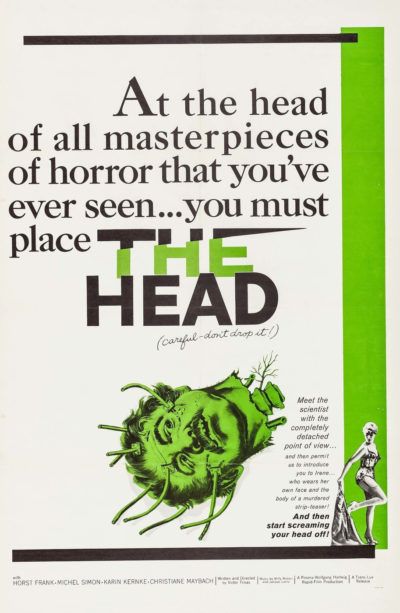 Considering we were still almost a decade before the first human heart transplant, this is ahead of its time. Indeed, I was distracted in the early going, looking up the Russian research mentioned [The unsettling short doc Experiments in the Revival of Organisms has you covered, if you are interested] There are some elements that have not survived well, and Sister Irene’s postoperative behaviour certainly seems un-Dominican, shall we say. But Frank holds the whole thing together, giving it a core that lets even modern viewers buy into the narrative. There’s no malarkey about advancing science, or this being necessary for the greater good. Dr. Ood just likes playing around with body parts, and has a long dubious medical record, as his conversation with the stripper demonstrates.
Considering we were still almost a decade before the first human heart transplant, this is ahead of its time. Indeed, I was distracted in the early going, looking up the Russian research mentioned [The unsettling short doc Experiments in the Revival of Organisms has you covered, if you are interested] There are some elements that have not survived well, and Sister Irene’s postoperative behaviour certainly seems un-Dominican, shall we say. But Frank holds the whole thing together, giving it a core that lets even modern viewers buy into the narrative. There’s no malarkey about advancing science, or this being necessary for the greater good. Dr. Ood just likes playing around with body parts, and has a long dubious medical record, as his conversation with the stripper demonstrates.
It definitely helps that Abel’s lab looks like a proper scientific facility. Production designer Hermann Warm had worked on the sets for The Cabinet of Dr. Caligari, almost forty years earlier, and all his experience probably makes this punch considerably above its B-movie weight. The ending, probably inevitably, sits in line with conventional morality, yet we are still left with a nun’s head sitting on the body of a murdered stripper. It’s an issue nobody seems keen to address or even acknowledge. Having gone into this expecting a Teutonic take on the usual disembodied brain nonsense, I was surprised how genuinely I enjoyed this, and not for the expected reasons of mockery.
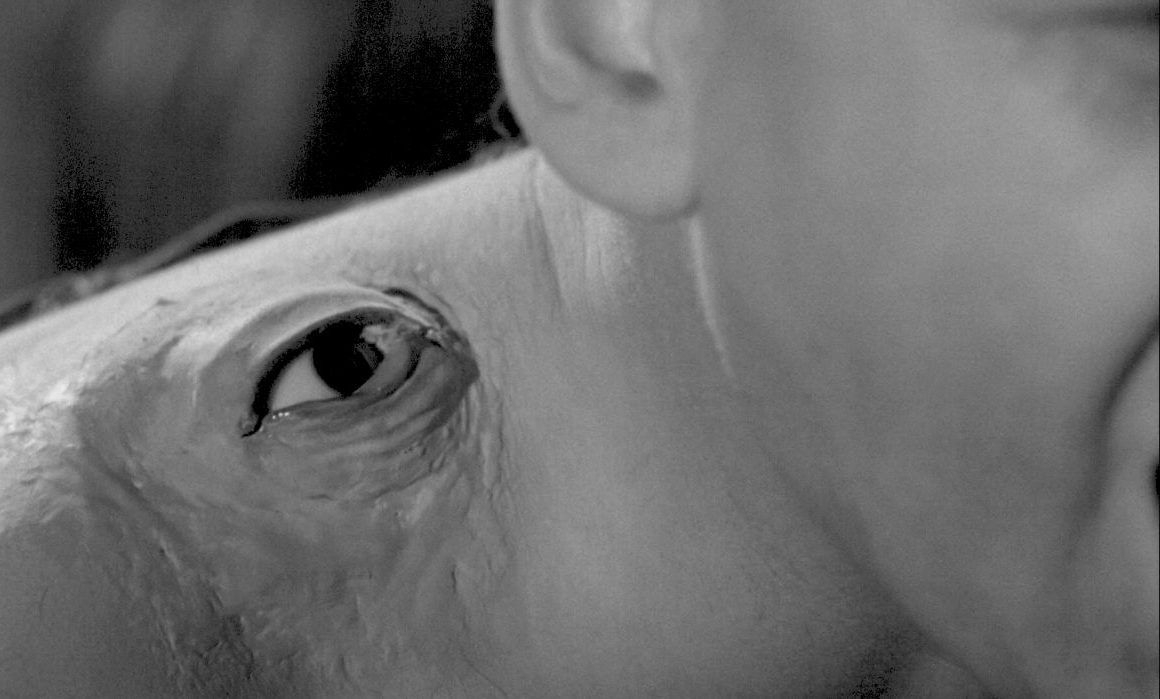
The Manster (1959)
Rating: C
Dir: George P. Breakston, Kenneth G. Crane
Star: Peter Dyneley, Terri Zimmern, Tetsu Nakamura, Jane Hylton
a.k.a. The Split
This is a little unusual, in that it’s an American production, but one filmed in Japan. While there had been some crossovers, the approach tended more often to be taking a Japanese film and adding footage for the US market, such as inserting Raymond Burr into a re-cut version of 1954’s Godzilla. This takes American actors and actually films them on location in Japan, alongside local players like Nakamura and Jerry Ito, who both appeared in Mothra. The effects and soundtrack also come with a “Made in Japan” label. It’s quite ambitious for what is, in many other ways, very much a B-movie.
Journalist Larry Stanford (Dyneley) is sent to interview reclusive scientist Dr. Robert Suzuki (Nakamura) at his laboratory on the side of a volcano. What he doesn’t realize is the doctor decides to make him the subject of some frankly questionable medical experiments, regarding triggering evolutionary change chemically. Surreptitiously dosing Larry, Dr. Suzuki sets his assistant, Tara (Zimmern), to keep tabs on the unwitting writer, who begins to change, both in his personality and then physically. The former leads to a break-up with his wife Lynda (Hilton); the latter… well, an itch in his shoulder develops into an eye (top), then an entire second head. Worse, it’s an “other half” which compels Robert to kill almost anyone who crosses his path, from a Buddhist priest to a psychiatrist.
 It’s basically a small-scale “monster on the rampage” film. This is perhaps most comparable to The Quatermass Experiment, not least in the way the victim conceals his hand, the obvious early manifestation of his ongoing metamorphosis. The Fly from the previous year is another influence, though the protagonist here is considerably less sympathetic. Right from the start, he seems creepily enthusiastic about whoring his way around Japan. Lines like, “You know, doc, I don’t know which I like better, Japanese sake or Japanese geisha,” have not aged well, and nor has telling Linda, “Maybe it’s because I never put you in your place before, never slapped you down when you needed it.” Yeah, hard to care much about Larry thereafter, even if it was the Manster talking.
It’s basically a small-scale “monster on the rampage” film. This is perhaps most comparable to The Quatermass Experiment, not least in the way the victim conceals his hand, the obvious early manifestation of his ongoing metamorphosis. The Fly from the previous year is another influence, though the protagonist here is considerably less sympathetic. Right from the start, he seems creepily enthusiastic about whoring his way around Japan. Lines like, “You know, doc, I don’t know which I like better, Japanese sake or Japanese geisha,” have not aged well, and nor has telling Linda, “Maybe it’s because I never put you in your place before, never slapped you down when you needed it.” Yeah, hard to care much about Larry thereafter, even if it was the Manster talking.
The special effects, especially for the second head, are not great. As in, they make Zaphod Beeblebrox from the BBC TV version of Hitchhiker’s Guide, look like the work of Industrial Light and Magic. Things generally work better before the head shows up, or at the end, when it becomes its own functioning entity (despite leaving Larry with his own, apparently intact, shirt). The performances help, with Nakamura good as the scientist prepared to do anything. There’s a particularly nasty revelation about the creature he keeps in a cage. It’s salutary to remember less than 15 years before this was made, Japanese scientists were doing especially brutal human experiments. Probably a bit of stretch to suggest this is a nod to Unit 731 though.
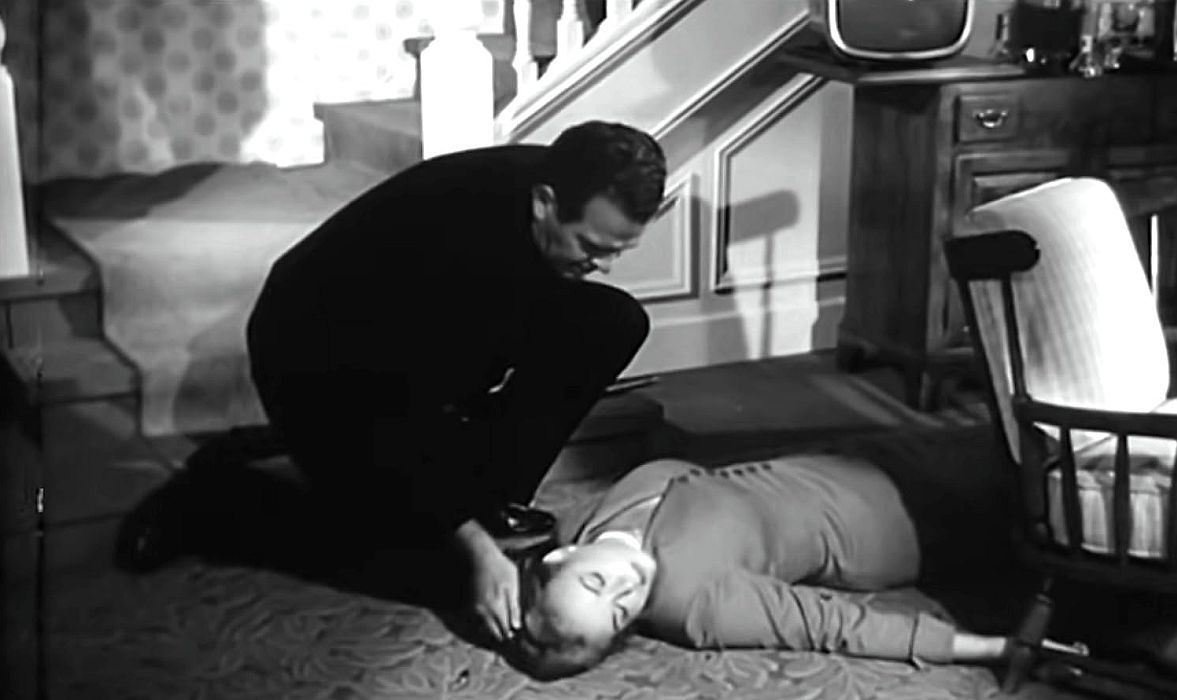
The Amazing Transparent Man (1960)
Rating: C+
Dir: Edgar G. Ulmer
Star: Douglas Kennedy, James Griffith, Marguerite Chapman, Ivan Triesault
Probably the least appropriate entry in the Brains That Wouldn’t Die collection. It’s much more of an Invisible Man knock-off, with the “gift” assigned to a career criminal who opts to go against the wishes of the scientist, Krenner, who bestowed it on him. The latter is a particularly nasty piece of work, with a fondness for slapping his moll around. I found myself surprisingly sympathetic to the other players, who are all manipulated by Krenner to do his bidding. Not that they’re exactly nice people. Indeed, it’s all impressively bleak, with a casual approach to nuclear devastation that can only be respected. “What would you do?” is the question explicitly directed to the viewer at the end. Um, let me get back to you on that?
[June 2015] This is likely a case of a film being contaminated through association with MST3K. While certainly cheap, and limited in both scope and execution, it’s more workmanlike than any kind of cinematic travesty, being technically sound. In terms of plot, it’s actually quite an interesting mix of noiresque SF. Safecracker Joey Faust (Kennedy) is broken out of prison at the behest of Paul Krenner (Griffith), who is working to create an “invisible army”, thanks to a ray developed (under duress) by Dr. Peter Ulof (Triesault). Kremner needs Faust to steal more of the atomic materials needed for the process, and turns him temporarily invisible to that end.
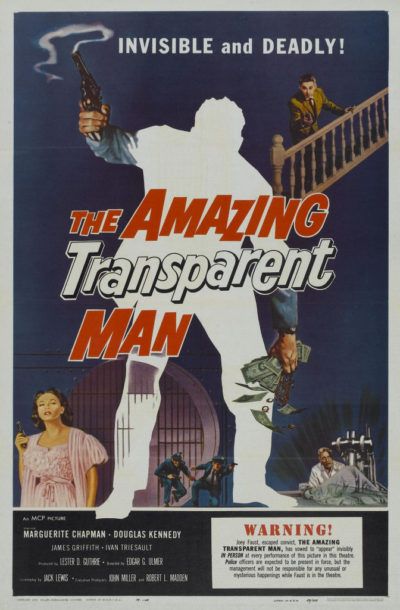 However, Faust has his own plans to utilize the potential open to an invisible man, and talks Kremner’s minion, Laura Matson (Chapman), into helping. Complicating matters: Faust doesn’t realize the guinea-pig on which the ray was tested, has dropped dead, and his invisibility is about to become intermittent in nature. The main criticism which could reasonably be levelled at this, is a cheerful lack of any scientific basis. But this isn’t surprising, given it was made in 1960, when radiation was kinder, gentler and capable of doing anything from creating giant ants to improving your health. The low budget is evident in 90% of its running-time being located in Kremner’s country house, and also said running-time being a mere 58 minutes. [It was shot back-to-back with another Ulmer film, Beyond the Time Barrier, a fortnight being enough to make both]
However, Faust has his own plans to utilize the potential open to an invisible man, and talks Kremner’s minion, Laura Matson (Chapman), into helping. Complicating matters: Faust doesn’t realize the guinea-pig on which the ray was tested, has dropped dead, and his invisibility is about to become intermittent in nature. The main criticism which could reasonably be levelled at this, is a cheerful lack of any scientific basis. But this isn’t surprising, given it was made in 1960, when radiation was kinder, gentler and capable of doing anything from creating giant ants to improving your health. The low budget is evident in 90% of its running-time being located in Kremner’s country house, and also said running-time being a mere 58 minutes. [It was shot back-to-back with another Ulmer film, Beyond the Time Barrier, a fortnight being enough to make both]
The performances are decent enough for the purpose, with Kennedy a good hard-boiled criminal, and Griffith a credible foil. While the effects here have certainly not dated well, this is by no means irredeemably bad: it’s a simple little B-picture, with no intentions of being other than an hour of entertainment. And you’ve got to love the disclaimer at the bottom right of the poster, which sounds right out of the William Castle playbook: “Joey Faust…has vowed to ‘appear’ invisibly at every performance of this picture in this theatre. Police officers are expected to be present in force, but the management will not be responsible for any unusual or mysterious happenings while Faust is in the theatre.” One can only imagine the hilarity that ensued…

The Brain That Wouldn’t Die (1962)
Rating; C
Dir: Joseph Green
Star: Jason Evers, Virginia Leith, Anthony La Penna, Adele Lamont
One of the most famous entries in the “isolated brain” genre, albeit significantly due to its lampooning by MST3K. It’s an odd beast, at times surprisingly earnest and almost heart-felt, while at others it fully deserves critical evisceration, and then some. The medical practitioner at the centre is Dr. Bill Cortner (Evers), who has been secretly experimenting in the basement lab of his country house. While driving there with fiancée Jan Compton (Leith), they’re involved in a car accident, in which Jan is decapitated. He hurries to his facility, with her severed head wrapped in a sports coat. She is kept alive – becoming what MST3K called “Jan in a pan” – while Bill searches for a replacement body he can transplant onto her head.
Jan is not happy about this situation, and wants simply to be left to die. For some unexplained reason, she has developed telepathy, and uses this to communicate with one of Bill’s earlier experiments. This monstrous creation, whom we eventually discover looks like a half-melted version of the Toxic Avenger (top), is locked up in a cupboard, and tended by Bill’s Igor-like assistant, Kurt (La Penna). Meanwhile, Dr. Cortner is visiting burlesque shows and beauty pageants, or simply kerb-crawling, seeking the perfect new body for Jan. Disfigured art model Doris Powell (Lamont) turns out to be that person, and is lured in by Bill with the promise of plastic surgery to fix her face.
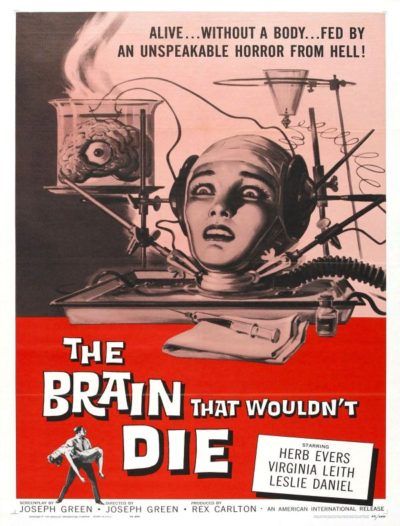 It begins on shaky ground, with near endless faux medical footage as Bill and his father, also a surgeon, pontificate forever. The drive of Bill and Jan to the estate, and subsequent crash, are both poorly executed, to the point of risible. Thereafter, however, it swings back and forth. Between Kurt and Doris, the film is unexpectedly sympathetic to the disabled, in particular the revulsion with with society views the disfigured. Jan and Kurt have a surprisingly honest conversation about why the later stays with Dr. Cortner. Kurt admits, “The alcoholic has his bottle, the dope addict his needle. I had my research.” It’s probably more of a legitimate justification for his actions than the doctor can offer. All we get from Bill is little more than, “Nothing is unbelievable if you have the nerve to experiment.”
It begins on shaky ground, with near endless faux medical footage as Bill and his father, also a surgeon, pontificate forever. The drive of Bill and Jan to the estate, and subsequent crash, are both poorly executed, to the point of risible. Thereafter, however, it swings back and forth. Between Kurt and Doris, the film is unexpectedly sympathetic to the disabled, in particular the revulsion with with society views the disfigured. Jan and Kurt have a surprisingly honest conversation about why the later stays with Dr. Cortner. Kurt admits, “The alcoholic has his bottle, the dope addict his needle. I had my research.” It’s probably more of a legitimate justification for his actions than the doctor can offer. All we get from Bill is little more than, “Nothing is unbelievable if you have the nerve to experiment.”
But for every decent moment, the film has two that are just terrible (albeit, sometimes in a highly amusing way). The peak is likely the world’s most tedious burlesque show, after which Bill goes backstage, and is literally fought over by two strippers. Then there’s a ludicrously over-extended death sequence after someone has their arm torn off by the closet monster. The victim subsequently runs around the house to no readily useful purpose, except for smearing blood on every surface. The impact is dimmed significantly by the film being in black-and-white. They might as well be an obnoxious child, finger painting with chocolate ice-cream in a tantrum. It’s all not very good, but I must confess, I was adequately entertained.
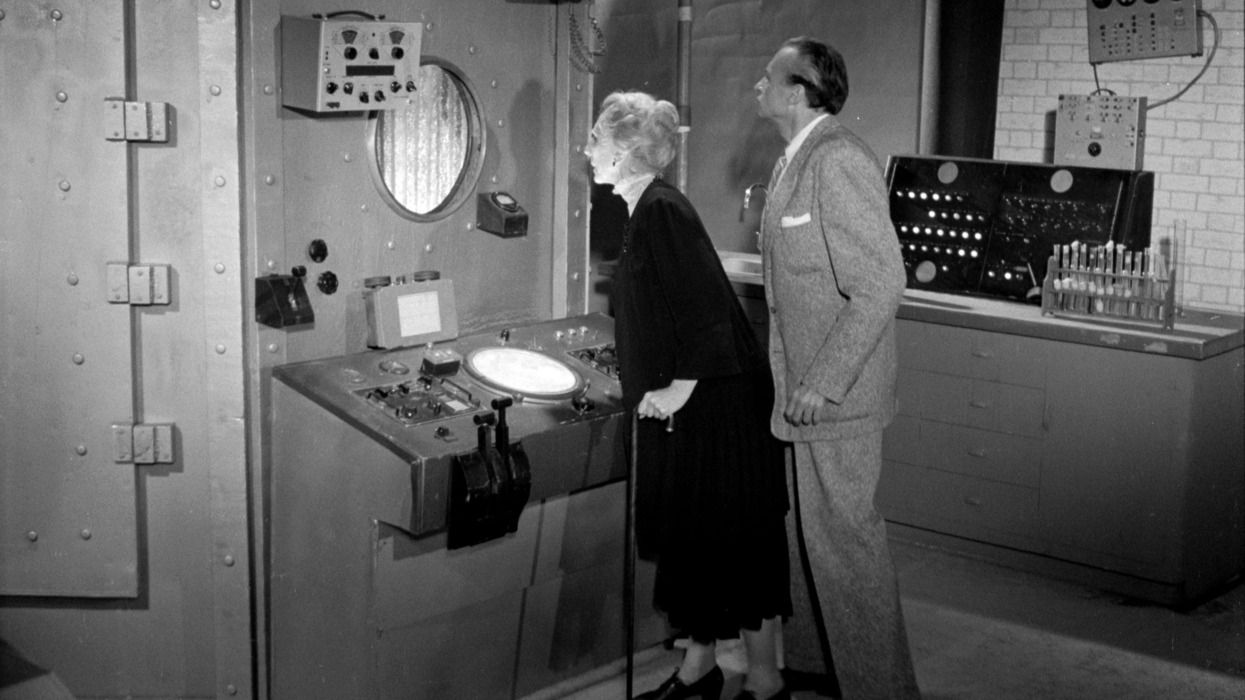
The Atomic Brain (1963)
Rating: D+
Dir: Joseph V. Mascelli
Star: Marjorie Eaton, Frank Gerstle, Erika Peters, Judy Bamber
a.k.a. Monstrosity
My previous review (below) largely stands, so I’m not going to go into great detail. But I wasn’t as impressed this time round. Perhaps knowing where it was going made a difference? The first half in particular seemed to drag badly, with an excess of voice-over in lieu of anything particularly interesting. I still like the general idea, though the idiocy of the three potential transplant victims would need to be addressed in any remake. I mean, not particularly wondering why your friend is suddenly acting like a moggie? I’d rather have seen the movie hinted at by the ending, in which a disgruntled cat goes on a trail of vengeance. Now, that would be something I haven’t seen before.
[June 2015] This is another case of a non-terrible film, unjustly maligned because those merry pranksters at MST3K got their claws into it. There’s enough here to suggest a remake would be a good idea: as I’ve said often enough, they should be remaking films with unfulfilled potential, not those which were already good to begin with. The central plot here revolves around rich, old lady Mrs. March (Eaton), who is intent on surviving past her body’s decay, and hires the unsubtly-named Dr. Frank (Gerstin) to find a way to transfer her consciousness into a younger, much less wrinkly body. To this end, she hires three foreign servants, who show up at her house, unaware they are actually candidates for an unwilling body donation.
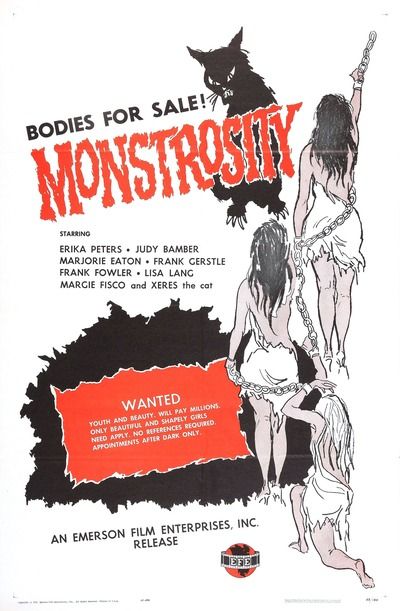 The Mexican one is found to be flawed, so is used by the Doctor for an experiment which succeeds in transferring the consciousness of a cat into her. [She spends most of the movie thereafter, coughing up hairballs, though does at least keep the house free of rodents]. The other two, allegedly Austrian Nina Rhodes (Peters) and even more allegedly “English” Bea Mullins (Bamber), realize something is up, and need to figure out how to escape Mad March’s plans for one of them. Disappointingly, the consciousness transplant appears to be a non-invasive procedure, involving a lot of flashing light and references to atomic stuff – this being 1963 – rather than surgery.
The Mexican one is found to be flawed, so is used by the Doctor for an experiment which succeeds in transferring the consciousness of a cat into her. [She spends most of the movie thereafter, coughing up hairballs, though does at least keep the house free of rodents]. The other two, allegedly Austrian Nina Rhodes (Peters) and even more allegedly “English” Bea Mullins (Bamber), realize something is up, and need to figure out how to escape Mad March’s plans for one of them. Disappointingly, the consciousness transplant appears to be a non-invasive procedure, involving a lot of flashing light and references to atomic stuff – this being 1963 – rather than surgery.
However, it is actually an interesting idea, and Eaton, whom you may (or may not) recognize from her bit-part in Mary Poppins, gives it her all, and makes this an early entry in the “biddy horror” genre. Gerstle, however, comes over as blandly uninteresting, and you wish the script had been handed over to Hammer. You sense they could have done much more with it, perhaps casting Peter Cushing as the Doctor, to add the necessary gravitas to aid with the necessary suspension of disbelief. [They’d at least have got the English accent right…] It might also have made a good Twilight Zone episode, especially the ending, which has a sneakily grim twist to it in a couple of ways. The admittedly numerous flaws, are less in the script than the performances and casting, along with production values that also struggle to reach a level commensurate with the concept. C
